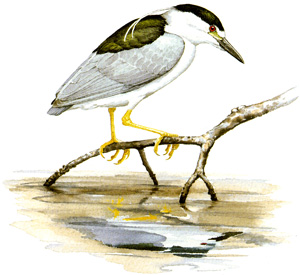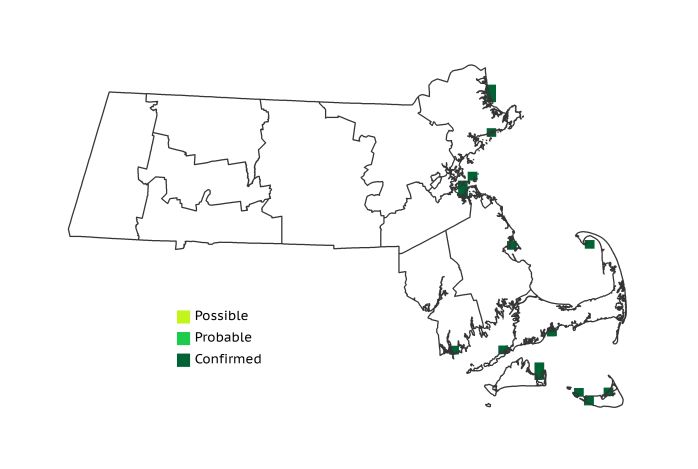Find a Bird
Black-crowned Night-Heron
Nycticorax nycticorax

Local and strongly increasing
Action/monitoring needed
State Wildlife Action Plan listed
“Some herons were fishing in the robes of the night / At a low hour of the water’s body,…” – Mary Oliver, “Night Herons”
The raven-like “quawk” and nocturnal habits of this species earned it the scientific name Nycticorax, which literally means “night-raven.” Of course, the Black-crowned Night-Heron is not a raven, but rather a heron, and it shares many similarities with other members of its family. It nests in colonies, hunts near water, and feeds on a wide variety of small vertebrates and insects. For decades, the species suffered from a combination of bioaccumulated pesticides and the extermination of its untidy rookeries by humans. Even though these pressures may have lessened, Black-crowned Night-Herons remain local and rarely encountered as a breeding species in Massachusetts.
Historic Status
From the early 1800s onward, bird observers in the Bay State called Black-crowned Night-Herons (or “Qua Birds,” for their odd vocalizations) common along the coast of Massachusetts during the breeding season. By the 1870s, chroniclers began noting their presence in winter as well, but it was their colonial nesting sites that drew the greatest attention (Howe & Allen 1901). Between 1915 and 1920, approximately 3,000 birds were known to inhabit three colonies in Massachusetts, but trouble was already on the way (Petersen & Meservey 2003). Unhappy with the colonies’ sounds and smells, landowners in the 1950s shot the birds en masse or even dynamited their heronries (Petersen & Meservey 2003), starting a population decline that may have been accelerated by overuse of toxic pesticides in the aftermath of World War II.
Atlas 1 Distribution
Historic persecution of this species for its perceived unneighborly ways notwithstanding, Black-crowned Night-Herons could be found at over a dozen different sites along the coast in Atlas 1. In addition to their presence at large heron colonies like House Island and Clark’s Island in the Coastal Plains, they were also found breeding at Plum Island. The Boston Harbor Islands hosted a trio of Black-crowned Night-Heron blocks. The only nesting birds in the Bristol/Narragansett Lowlands were at Ram Island, but the Cape and Islands region had no fewer than 8 Confirmed breeding blocks, including multiple sites on Martha’s Vineyard and Nantucket.
Atlas 2 Distribution and Change
Minor shifts in colony locations were all that separated Atlas 2 from Atlas 1 as far as Black-crowned Night-Herons are concerned, except for one inland Confirmation in a block that falls mostly in Connecticut. For the most part, the Confirmations came in the same blocks in Atlas 2 as in Atlas 1, meaning that the old established heronries were still going strong. Consistency has been the keyword: “Black-crowns” nested in 1.7% of all blocks in Atlas 1 and in 4.6% of all blocks in Atlas 2.
Atlas 1 Map

Atlas 2 Map

Atlas Change Map

Ecoregion Data
Atlas 1 | Atlas 2 | Change | ||||||
Ecoregion | # Blocks | % Blocks | % of Range | # Blocks | % Blocks | % of Range | Change in # Blocks | Change in % Blocks |
Taconic Mountains | 0 | 0.0 | 0.0 | 0 | 0.0 | 0.0 | 0 | 0.0 |
Marble Valleys/Housatonic Valley | 0 | 0.0 | 0.0 | 0 | 0.0 | 0.0 | 0 | 0.0 |
Berkshire Highlands | 0 | 0.0 | 0.0 | 0 | 0.0 | 0.0 | 0 | 0.0 |
Lower Berkshire Hills | 0 | 0.0 | 0.0 | 0 | 0.0 | 0.0 | 0 | 0.0 |
Vermont Piedmont | 0 | 0.0 | 0.0 | 0 | 0.0 | 0.0 | 0 | 0.0 |
Berkshire Transition | 0 | 0.0 | 0.0 | 0 | 0.0 | 0.0 | 0 | 0.0 |
Connecticut River Valley | 0 | 0.0 | 0.0 | 1 | 1.5 | 2.1 | 1 | 2.1 |
Worcester Plateau | 0 | 0.0 | 0.0 | 0 | 0.0 | 0.0 | 0 | 0.0 |
Lower Worcester Plateau | 0 | 0.0 | 0.0 | 1 | 1.3 | 2.1 | 0 | 0.0 |
S. New England Coastal Plains and Hills | 4 | 1.5 | 25.0 | 18 | 6.4 | 37.5 | 11 | 4.9 |
Boston Basin | 3 | 5.4 | 18.8 | 8 | 14.3 | 16.7 | 5 | 9.1 |
Bristol and Narragansett Lowlands | 1 | 0.9 | 6.3 | 3 | 2.6 | 6.3 | 2 | 2.0 |
Cape Cod and Islands | 8 | 5.9 | 50.0 | 17 | 11.8 | 35.4 | 7 | 5.8 |
Statewide Total | 16 | 1.7 | 100.0 | 48 | 4.6 | 100.0 | 26 | 3.1 |
Notes
Black-crowned Night-Herons show a significant decreasing Breeding Bird Survey (BBS) trend in Massachusetts. They fall into our “whispering bird” category – those species with a demonstrated stable or increasing breeding footprint from Atlas 2 data, but also a demonstrated decline in abundance from the BBS. This drives our final assessment that this is a species with a need for further monitoring. Atlas methods are not the preferred methods for censusing changes in colonially nesting species. Atlas cells will “light up” regardless of whether a colony has 1 or 100 nests, so, while the species footprint in the state may appear be unchanged or even increasing, the same species’ abundance may be greatly diminished. There is more evidence for decline in this species. Contrasting the actual counts at colonies with their breeding footprint is informative, and surveys by the state Natural Heritage & Endangered Species Program revealed dramatic declines in the numbers of pairs at some rookeries. Data indicate a drop from 1,428 nesting pairs in 1994/95 to 781 in 2007/08. While there are some challenges in comparing these numbers due to changes in methods of the counts, most of the colonies surveyed in 2007/08 were notably smaller, or were empty, when compared with the previous survey.



